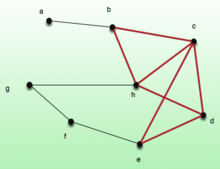Dense subgraph

In computer science the notion of highly connected subgraphs appears frequently. This notion can be formalized as follows. Let be an undirected graph and let be a subgraph of . Then the density of is defined to be .
The densest subgraph problem is that of finding a subgraph of maximum density. In 1984, Andrew V. Goldberg developed a polynomial time algorithm to find the maximum density subgraph using a max flow technique.
Densest k subgraph
There are many variations on the densest subgraph problem. One of them is the densest subgraph problem, where the objective is to find the maximum density subgraph on exactly vertices. This problem generalizes the clique problem and is thus NP-hard in general graphs. There exists a polynomial algorithm approximating the densest subgraph within a ratio of for every ,[1] while it does not admit PTAS unless .[2] The problem remains NP-hard in bipartite graphs and chordal graphs but is polynomial for trees and split graphs.[3] It is open whether the problem is NP-hard or polynomial in (proper) interval graphs and planar graphs; however, a variation of the problem in which the subgraph is required to be connected is NP-hard in planar graphs.[4]
Densest at most k subgraph
The objective of the densest at most problem is to find the maximum density subgraph on at most vertices. Anderson and Chellapilla showed that if there exists an approximation for this problem then that will lead to an approximation for the densest subgraph problem.
Densest at least k subgraph
The densest at least problem is defined similarly to the densest at most subgraph problem. There is a 2-approximation due to Anderson. It is also NP-complete.[5]
K-clique densest subgraph
Charalampos Tsourakakis introduced the -clique densest subgraph problem. This variation of the densest subgraph problem aims to maximize the average number of induced cliques , where is the set of -cliques induced by . Notice that the densest subgraph problem is obtained as a special case for . This generalization provides an empirically successful poly-time approach for extracting large near-cliques from large-scale real-world networks.
References
- ↑ Bhaskara, Aditya; Charikar, Moses; Chlamtáč, Eden; Feige, Uriel; Vijayaraghavan, Aravindan (2010), "Detecting high log-densities—an O(n1/4) approximation for densest k-subgraph", STOC'10—Proceedings of the 2010 ACM International Symposium on Theory of Computing, ACM, New York, pp. 201–210, doi:10.1145/1806689.1806719, MR 2743268.
- ↑ Khot, Subhash (2006), "Ruling out PTAS for graph min-bisection, dense k-subgraph, and bipartite clique", SIAM Journal on Computing, 36 (4): 1025–1071, CiteSeerX 10.1.1.114.3324
 , doi:10.1137/S0097539705447037, MR 2272270.
, doi:10.1137/S0097539705447037, MR 2272270. - ↑ Corneil, D. G.; Perl, Y. (1984), "Clustering and domination in perfect graphs", Discrete Applied Mathematics, 9 (1): 27–39, doi:10.1016/0166-218X(84)90088-X, MR 754426.
- ↑ Keil, J. Mark; Brecht, Timothy B. (1991), "The complexity of clustering in planar graphs" (PDF), Journal of Combinatorial Mathematics and Combinatorial Computing, 9: 155–159, MR 1111849.
- ↑ Khuller, Samir; Saha, Barna (2009), "On finding dense subgraphs" (PDF), Automata, Languages and Programming: 36th International Colloquium, ICALP 2009, Rhodes, Greece, July 5-12, 2009, Proceedings, Part I, Lecture Notes in Computer Science, 5555, Berlin: Springer-Verlag, pp. 597–608, doi:10.1007/978-3-642-02927-1_50, MR 2544878
Additional reading
- Anderson, R.; Chellapilla, K. (2009), "Finding dense subgraphs with size bounds", WAW: 25–36.
- Anderson, R. (2007), Finding large and small dense subgraphs, arXiv:cs/0702032
 .
. - Feige, U.; Kortsarz, G.; Peleg, D. (1997), "The dense k-subgraph problem", Algorithmica, 29: 410–421, doi:10.1007/s004530010050.
- Goldberg, A. V. (1984), "Finding a maximum density subgraph", Technical report.
- Tsourakakis, C. (2015), "The k-clique densest subgraph problem", The International World Wide Web Conference, doi:10.1145/2736277.2741098.